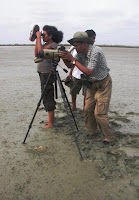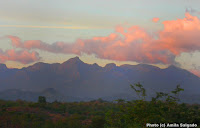
Kusum, a birding pal, and I organised a 2-day "water birds and sea food trip" from 11 to 12 Aug., 2007. It served two puposes: to catch the early arrivals of winter migrants and to increase our blood cholesterol levels measurably. We were joined by several of our birding buddies: Mihiri, Umesh, Ayanthi, Rohantha, Madhu, Kishan and Devi—latter an MD—our doctor on call, just in case.
Our overnight base was a private Bungalow close to Kalpitiya, named the Turtle Point, which was recommended by Sandali Wijayatilake, who had been there in April and alledgely seen the highly sought-after Crab Plover nearby. All my previous sightings of this Deccan avi-faunal zone rarity had been in the Talaimannar area in Mannar, so one of the ulterior motives of this trip was to find it in a site more accessible.
We left Colombo very early and reached our first birding spot, Chilaw Sandspits—a wader patch in the western coast, north of the airport. It was too early in the season for the Sanderlings, which are usually found wintering here. But, we found a few early arrivals in the form of Common Sandpiper, Common Greenshank, and several Eurasian Whimbrel in the shoreline. A pair of Great Thick-knees and several Great Crested Terns also were noted. I was the only person with a scope, so as usual, there was a neat queue to take turns for better views.
Chilaw Sandspits is situated close to a fishing hamlet. Several of our participants had to experience ‘too much of reality’ too early in the morning. But what can I say? I had warned them precisely of such "ground realities."

Breakfast at the Chilaw Resthouse was good and Kusum fell 10 short of his alltime string-hopper-eating record—gobbling 70!
This was with fish, potato, and dhal curries; plus pol sambol. The fish curry was a bit on the hot, and this was made an excuse to eat two slices of bread on top of it—in a bid put off the fire in his mouth!

With our bellies full, we drove to the Annaiwilundawa RAMSAR wetland, which not surprisingly for this time of the year, was very dry—with its network of tanks reduced to small ponds here and there. A noteworthy birding highlight was Large Cuckoo-shrike, which is somewhat of a regular at this site.
Cotton Pygmy-goose, Oriental Darter, Pied Kingfisher, Green Bee-eater, Indian Roller, Black-headed Ibis, Purple Heron and the four species of white Egrets, came in quick order. Thereafter, we drove up to the Puttlam Saltpans, which appeared devoid of birds at the first glance. It was so desolate that we almost turned back before we spotted a couple of small flocks of waders comprising of Little Stint, Curlew Sandpiper, Kentish Plover, and Lesser Sand Plover—all retaining variable degrees of summer plumage. Some of those Curlew Sandpipers were almost in full summer with their beautiful brick-red plumages.
Several Gull-billed Terns were also spotted settled down close by. Returning to our vehicle baked in the blazing Puttlam sun, the organisers of the trip bedazzled the lot with some chilled soft drinks pulled out from a a coolbox tucked inside a seat. A few brownie points.
We broke for lunch at the good old Puttlam Resthouse, and since this is not a FOGSL trip, some of us had the luxury to replenish the lost liquids properly with chilled Lion beer with devilled cuttle fish as "bites" (Sri Lankans almost never drink without bites—which are often spicy/fired dishes with liberal amounts of chillie and high fat eating thingies).
Next, we enjoyed an artery-clogging rice and curry lunch—with more cuttle fish, prawns curry, and some fish curry for those who didn't like prawns and cuttlefish.

Post lunch, we explored the vast expanse of Palavi mudflats.
As soon as getting off the vehicle, I picked up the call of a Grey Francolin—yet another deccan avi-faunal zone specialty. It was my first at this site. We looked for it but had no luck. It was extremely dry here, as expected, resulting in the wader patches being too far from the roadside. I saw not much point in trying to scope things from the roadside so Rohantha, Mihiri and Umesh agreed to walk up to the wader flocks following my ASS (advance-stop-scan) technique.
We had to report to our accommodation at around 5ish with the dry rations that we had brought along, in order for the caretaker family to cook our dinner. So this meant we could ASS only 750m. However, this was enough to find several high profile early migrants in the form of a grey morph Western Reef Egret, at least five Broad-billed Sandpipers, and Grey Plover. Those who stayed back in the dry land had also picked up blobs of the Grey Plover and the Western Reef Egret, but had missed the Broad-billed Sandpipers.
Returning to our vehicle, we accidentally flushed a Grey Francolin, a lifer for the rest. A BVD, of course.
After getting some ice from an ice factory to cool our food and beverages, we drove to the fish market in Kalpitiya to buy some seafood. It was here that another one of my techniques came in real handy. When we turned up at the fish market, all the fish vendors, who happened to wholesale fish dealers, didn’t care about us townies wanting small quantities of fish. And they gave us ‘Colombo prices!’.
One of the interesting things about our culture (shared also with certain other eastern cultures) is addresing complete strangers in kinship terms. So I addressed the vendor that I was speaking to ‘Ayye’ (elder brother), for he clearly looked older than me. This not only conveyed respect, but also put me in equal level with him socially. To be effective, I used it more often in my sentences than I would do it normally.
And Lo and behold!
It really worked as that bloke who seemed rude, and unfriendly at first really loosened up. We were quoted Rs. 1,200 per 1 kg of ‘jumbo’ Prawns initially but thanks to my heart-melting Ayyefying, we walked away with the same quantity paying just Rs. 500, which was a great bagain!
Similarly, I Ayyefyed another vendor to get a 2.8 kg Paraw Fish (Black-Tip Trevally,) at fraction of the Colombo prices! And I did this wearing my shorts and looking more like one of them.

We reached our accommodation around 5.30p.m., to be greeted by our friendly caretaker, Lional, who looked after us extremely well during our stay. The Turtle Point has three rooms (one with two beds, and two with three beds) each coming with private facilities. Note it has no electricity. Also, there are also extra beds that can be used if you want to sleep out in the veranda, which is what Kishan, and I did as it was a bit stuffy inside the room. More liquids, checklist and a fine seafood dinner marked the end of a great day.
A pre-breakfast birding walk on the following day along the shoreline was productive with steady flows of Brown-winged (Bridled) Terns, a passage migrant flying south, close to the shoreline. This proved a lifer for some. Also seen here were Little, Common, Large Crested, and Lesser Crested Terns, in addition to Black-winged Stilt and more Eurasian Whimbrels. Other highlights were early arrivals of Ruddy Turnstone, Little Stint, Common Greenshank, Wood Sandpiper, and Curlew Sandpiper—all showing of summer and summer to winter transitional plumages in varying degrees.
No luck with Crab Plover. Our breakfast was rice with dhal curry, pol sambol and more Paraw fish curry.
Our exportations until lunch didn’t produce anything spectacular, and after another superb lunch, we bid farewell to Lionel and his family and drove to the Nawadankulama Tank. Here we had 19 Common Coots, a locally uncommon bird, and many Little Grebes feeding in formation. I also heard a yet another deccan avi-faunal zone specialty in the form of Eurasian Collard Dove, which would have been a lifer for the rest.
We returned home with copious quantities of Jumbo Prawns –the bloke charged only Rs. 450 per kg!
The above was my submission for I and The Bird #63 hosted by The Greenbelt
































